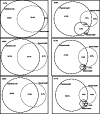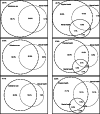How does the sexual, physical and mental health of young adults not in education, employment or training (NEET) compare to workers and students?
- PMID: 33637055
- PMCID: PMC7908525
- DOI: 10.1186/s12889-021-10229-6
How does the sexual, physical and mental health of young adults not in education, employment or training (NEET) compare to workers and students?
Abstract
Background: Syndemic theory highlights the potential for health problems to interact synergistically, compounding impact. Young adults not in education, employment or training (NEET) are more likely to experience disadvantage and poorer general health outcomes. However, there is little research on their sexual health, or the extent to which this clusters with mental and physical health outcomes.
Methods: Analysis of data from 16 to 24 year olds (1729 men, 2140 women) interviewed 2010-12 for Britain's third National Survey of Sexual Attitudes and Lifestyles. Natsal-3 is a national probability sample survey using computer-assisted personal interviewing with computer-assisted self-interviewing. Participants were classified as workers, students or NEET. We used multivariable logistic regression to examine associations between being NEET (relative to worker or student) and risk behaviours and outcomes in physical, sexual and mental health domains. We then examined how risk behaviours and poor health outcomes cluster within and across domains.
Results: 15% men and 20% women were NEET; 36% men and 32% women were workers; and 49% men and 48% women were students. Young people who were NEET were more likely to report smoking and drug use (men) than other young people. There were few differences in sexual health, although NEETs were more likely to report condomless sex, and NEET women, unplanned pregnancy (past year). Risk behaviours clustered more within and across domains for NEET men. Among NEET women, poor health outcomes clustered across mental, physical and sexual health domains.
Conclusions: Harmful health behaviours (men) and poor health outcomes (women) clustered more in those who are NEET. This points to a possible syndemic effect of NEET status on general ill health, especially for women. Our paper is novel in highlighting that elevated risk pertains to sexual as well as mental and physical health.
Keywords: Clustering; Cross-sectional survey; Not in education, employment or training (NEET); Sexual health.
Conflict of interest statement
The authors declare that they have no competing interests.
Figures


Similar articles
-
The health and well-being of men who have sex with men (MSM) in Britain: Evidence from the third National Survey of Sexual Attitudes and Lifestyles (Natsal-3).BMC Public Health. 2016 Jul 7;16:525. doi: 10.1186/s12889-016-3149-z. BMC Public Health. 2016. PMID: 27386950 Free PMC article.
-
Cancer-related health behaviours of young people not in education, employment or training ('NEET'): a cross-sectional study.BMC Cancer. 2017 Mar 2;17(1):165. doi: 10.1186/s12885-017-3157-0. BMC Cancer. 2017. PMID: 28253843 Free PMC article.
-
Illicit drug use and its association with key sexual risk behaviours and outcomes: Findings from Britain's third National Survey of Sexual Attitudes and Lifestyles (Natsal-3).PLoS One. 2017 May 18;12(5):e0177922. doi: 10.1371/journal.pone.0177922. eCollection 2017. PLoS One. 2017. PMID: 28542366 Free PMC article.
-
A cross-sectional exploration of the clinical characteristics of disengaged (NEET) young people in primary mental healthcare.BMJ Open. 2014 Dec 23;4(12):e006378. doi: 10.1136/bmjopen-2014-006378. BMJ Open. 2014. PMID: 25537785 Free PMC article.
-
Rural NEETs School to Work Transitions: A Conceptual Model Based on the Psychology of Working Theory.J Adolesc. 2025 Jun 15. doi: 10.1002/jad.12534. Online ahead of print. J Adolesc. 2025. PMID: 40518682 Review.
Cited by
-
Temporal Trends and Differences in Sexuality among Depressed and Non-Depressed Adults in the United States.Int J Environ Res Public Health. 2022 Oct 27;19(21):14010. doi: 10.3390/ijerph192114010. Int J Environ Res Public Health. 2022. PMID: 36360889 Free PMC article.
-
The health status of South African youth joining Youth Employment Initiatives: a health promotion opportunity.Health Promot Int. 2025 May 13;40(3):daaf061. doi: 10.1093/heapro/daaf061. Health Promot Int. 2025. PMID: 40402012 Free PMC article.
-
Developing a hope-focused intervention to prevent mental health problems and improve social outcomes for young women who are not in education, employment, or training (NEET): A qualitative co-design study in deprived coastal communities in South-East England.PLoS One. 2024 May 31;19(5):e0304470. doi: 10.1371/journal.pone.0304470. eCollection 2024. PLoS One. 2024. PMID: 38820387 Free PMC article.
-
Self-rated health and quality of life in female sex workers with substance use disorders in Tehran, Iran.BMC Womens Health. 2023 Aug 1;23(1):403. doi: 10.1186/s12905-023-02552-4. BMC Womens Health. 2023. PMID: 37528431 Free PMC article.
References
-
- Macdowall W, Gibson LJ, Tanton C, Mercer CH, Lewis R, Clifton S, et al. Lifetime prevalence, associated factors, and circumstances of non-volitional sex in women and men in Britain: findings from the third National Survey of sexual attitudes and lifestyles (Natsal-3) Lancet. 2013;382(9907):1845–1855. doi: 10.1016/S0140-6736(13)62300-4. - DOI - PMC - PubMed
-
- Wellings K, Jones KG, Mercer CH, Tanton C, Clifton S, Datta J, et al. The prevalence of unplanned pregnancy and associated factors in Britain: findings from the third National Survey of sexual attitudes and lifestyles (Natsal-3) Lancet. 2013;382(9907):1807–1816. doi: 10.1016/S0140-6736(13)62071-1. - DOI - PMC - PubMed
-
- Sonnenberg P, Clifton S, Beddows S, Field N, Soldan K, Tanton C, et al. Prevalence, risk factors, and uptake of interventions for sexually transmitted infections in Britain: findings from the National Surveys of sexual attitudes and lifestyles (Natsal) Lancet. 2013;382(9907):1795–1806. doi: 10.1016/S0140-6736(13)61947-9. - DOI - PMC - PubMed
-
- Public Health England. Sexually Transmitted Infections and Chlamydia Screening in England, 2016. Health Protection Report11(20).
-
- Office for National Statistics. Crime Suvery for England and Wales . 2nd. edn. ed. Essex: Colchester; 2011.
MeSH terms
Grants and funding
LinkOut - more resources
Full Text Sources
Other Literature Sources
Medical
Miscellaneous

